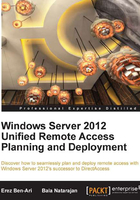
Multiple stacks
Pretty much every operating system released in over a decade supports IPv6 and we refer to this as dual stack—both an IPv4 TCP/IP stack and IPv6 TCP/IP stack. You would have probably noticed this in your network interface configuration page:

The reality is that a lot of administrators aren't sure why they need this and disable the IPv6 option on all their computers. This might be some misguided attempt to optimize the network, such as disabling NetBIOS, but in reality, it would be a pretty bad idea. By disabling IPv6, you're limiting the computer's options and so Microsoft recommends keeping this enabled. If you've been doing this for a while, it's time to start thinking how to undo it. The easiest way would probably be by running a script on all hosts via your domain login script. The article available at http://support.microsoft.com/kb/929852 can help you make this happen (though it applies to Windows 2008 servers and onward only).
This is even more important on the URA server itself. If you've implemented disabling IPv6 automatically in any way, make sure your URA server is excluded from this. Without IPv6, the URA server cannot perform its role.